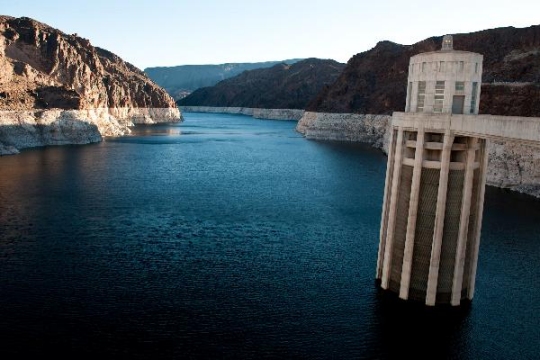 Lake Mead, the reservoir created by Hoover Dam, is at its lowest water level since the lake's initial filling in the 1930s. (Photo:
Bureau of Reclamation, CC BY-SA 2.0 license via Flickr)
Lake Mead, the reservoir created by Hoover Dam, is at its lowest water level since the lake's initial filling in the 1930s. (Photo:
Bureau of Reclamation, CC BY-SA 2.0 license via Flickr)God bless the summer rainstorms.
If you've felt annoyed by these deluges, there's a reason. You're insane, like most of us.
We Americans love a sunny day, a bright blue dome and flat green landscape, though we live mostly indoors and wouldn't know if a meteor had crashed down across the street.
We also love our coffee and microbrews, our local growers and meat-on-the-grill, our money and our lives. But we don't tend to love the source of these: rain, snow—and landscapes that welcome them into the ground.
This incongruity, combined with other factors, has taken its toll.
"The water table is dropping all over the world," says Jay Famiglietti, senior NASA hydrologist.
Famiglietti's research team revealed, via satellite data, we humans are depleting our world's biggest aquifers much faster than precipitation can restore them. "We're not just up a creek without a paddle," he says, "we're losing the creek too."
Surface water levels—rivers, even vast reservoirs like Lake Meade—are likewise dropping to historic lows. Famiglietti compares those surface waters to cash flow—a daily spending source meant to be replenished by deposits into local groundwater accounts.
But the deep aquifers we've grown dependent on were to be the planet's long-term savings, not daily cash to squander.
Why not recharge and restore all of these valuable water accounts, with policies and landscapes that plug precipitation back into the ground and then conserve it?
Well, because water-waste is addictive. It can spur quick temporary cash on the surface, thus luring entire regions to depend on the crazy habit.
That's why the western U.S. is running out of water. Ancient aquifers now irrigate (and evaporate through) thirsty crops on hot arid landscapes—desert, or prairies once covered by rain-conserving, deep-root grasses.
Frackers also squander these prehistoric waters to extract the natural gas we burn up in short shrift.
Such practices have left America's entire economy and food supply propped up by water waste, with no "what next" plan for depletion—and oddly, no efforts to conserve.
Water laws in the U.S. are in fact among the flabbiest on the planet, so conducive to looting this national treasury that Saudi investors have purchased land tracts—with free water access—in drought-stricken California and Arizona.
There, it's legal to buy some acreage, dig a well and extract millions of deep gallons to grow temporary cattle-feed, which the Saudis then export to their herds. It's cheaper than shipping water itself.
But it's not cheap for neighbors of these projects, whose wells keep going dry, or for the nation's invaluable water bucket already riddled with holes.
Meanwhile "back East," in formerly wet states, we too are up a dry creek. Population density, impervious development and hotter, drier summers have increased water expenditures while decreasing deposits.
Record low levels in Lake Lanier, near Atlanta, have intensified a "Tri-state Water War" between Georgia, Alabama and Florida.
Here in the Mid-Atlantic, coastward areas like southern Maryland and eastern Virginia keep digging deeper into aquifers that are dropping toward saltwater levels.
Much of this could be solved by rehydration, and not just of the land. Tapping the human heart's artesian well of "care"—that artery connecting us to the whole of life—could inspire a deeper look at our surface world.
Thin-soiled and shadeless lawns, vast griddles of parking blacktop, paved driveways dumping into streets—all shunt precipitation straight down storm-drains, then rivers. This valuable freshwater cargo, intended to bless the land, is instead mixed with pollutants and rushed to the coast, where it contributes to dead zones and sea-rise.
Why promote and reward such impoverishing landscapes? Directives for permeable, water-saving design abound via state agencies, university extensions and groups like the Permaculture Research Institute or Chesapeake Bay Foundation.
But you yourself need to plug in. Next time it rains, you might irrigate your mind by stepping outside to notice. Where does this valuable water flow and vanish? Where might it be invested into the ground and saved, via trees, native plants and protective humus?
It is not beyond us to pick up a shovel, plant some natives and restore topsoil—backyard, churchyard, cemetery, campus or hospital grounds. Instead of grass, why not rain gardens or groves? Instead of asphalt deserts, why not permeable grids and tree shade?
Nature gave us a wealth of answers to the water crisis long ago. We may not be able to stir up rainstorms, but we can stir ourselves to value and conserve such liquid assets when they flow our way.
Liza Field is a conservationist, tree-planter and ethics teacher in Southwest Virginia.


